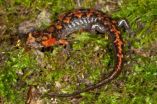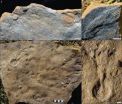(Press-News.org) A new study from the Wildlife Conservation Society finds that several iconic Adirondack birds are in trouble, with declines driven by the size of their wetland habitats, how connected these wetlands are to one another, and how near they are to human infrastructure.
The Adirondack Park represents the southern range extent for several species of boreal forest birds in eastern North America. Like any species at the edge of its range, they face challenges in this environment. The habitats of these boreal specialists – cool, wet, sphagnum-draped bogs and swampy woods – are thought to be vulnerable to climate change, particularly in the Adirondacks where they are more fragmented than in forest to the north.
In her paper, "Dynamics of Boreal Birds at the Edge of Their Range in the Adirondack Park, NY," author and WCS Adirondack Program Science Director Michale Glennon explores occupancy patterns over time for eight bird species in lowland boreal forest wetlands in the Adirondacks. The study, which appears in Northeastern Naturalist (2014, Volume 21, Issue 1), presents an evaluation of the potential influence of climate change and habitat alteration on species occurrence patterns over time.
A total of 1,105 count surveys conducted between 2007 and 2011 in wetlands ranging in size from 0.04—6.0 square kilometers resulted in 1,305 detections of target species, with yellow-bellied flycatcher (30 percent), Lincoln's sparrow (23 percent), and yellow palm warbler (20 percent) detected most often, and fewer detections of black-backed woodpecker (8 percent), gray jay (8 percent), olive-sided flycatcher (6 percent), boreal chickadee (3 percent), and rusty blackbird (2 percent).
Patterns of species occurrence from year to year indicated that these birds function as metapopulations (spatially separated members of the same species that interact with one another through migration in and out of habitat patches). Glennon found that the area and connectedness of their wetland habitats were important, as was nearby human infrastructure, with birds much more likely to disappear from smaller, isolated wetlands that are near development.
Occupancy rates for four of the eight study species were in decline; two appeared stable, and only Lincoln's sparrow and palm warbler appeared to be increasing in the Adirondack landscape. However, data collected since the study indicate that the situation may be getting worse.
"When I incorporate data collected since 2011, I am seeing declines for all species except palm warbler, some modest but some of them more troubling," said Michale Glennon. "The number of boreal wetlands occupied by five species – rusty blackbird, gray jay, yellow-bellied flycatcher, olive-sided flycatcher, and black-backed woodpecker – has decreased by 15 percent or more since 2007."
Glennon also looked at whether the birds appear to be shifting to higher latitudes and/or elevations, a pattern documented for many species responding to climate change around the globe. The analysis yielded inconsistent results (some birds moving northward or upward, some not), suggesting that over this small window of time, other factors may be playing a larger role in controlling these species' dynamics.
Glennon said, "The species in question are icons of the area and a big reason bird-watchers come to the Adirondacks. It is alarming to think that we can lose them here, of all places. They are very specialized species, however, and have specific habitat needs. In addition to the stresses of a warming climate, they may face competition and displacement from more cosmopolitan birds like blue jays which tend to come along with residential development."
WCS Adirondack Program Director Zoe Smith said, "Understanding the processes that drive the dynamics of boreal birds in the Adirondacks can enhance the ability of land managers to influence their long-term conservation. WCS will continue to study these birds and other wildlife of the boreal to help contribute to the long term protection of this vulnerable habitat."
In addition to songbirds and woodpeckers, boreal wetlands provide critical habitat for other park icons like moose, loon, and marten.
INFORMATION:
This research was made possible by the New York State Department of Environmental Conservation State Wildlife Grants Program, the Northern New York Audubon Joseph and Joan Cullman Foundation Grants Program, and other generous supporters.
Iconic boreal bird species declining in the Adirondacks, study says
2014-04-10
ELSE PRESS RELEASES FROM THIS DATE:
Uncovering a new angle on mental distance
2014-04-10
Why does the second hour of a journey seem shorter than the first? According to research from University of Toronto Scarborough (UTSC) and the Rotman School of Management, the answer lies in how we're physically oriented in space.
In a series of six studies, Sam Maglio, an assistant professor in UTSC's Department of Management, demonstrated that a person's orientation — the direction they are headed — changed how they thought of an object or event.
The research is forthcoming in Psychological Science, a journal of the Association for Psychological Science.
"Feeling ...
Sunlight generates hydrogen in new porous silicon
2014-04-10
Porous silicon manufactured in a bottom up procedure using solar energy can be used to generate hydrogen from water, according to a team of Penn State mechanical engineers, who also see applications for batteries, biosensors and optical electronics as outlets for this new material.
The surface area of this porous silicon is high," said Donghai Wang, assistant professor of mechanical engineering. "It is widely used and has a lot of applications."
The standard method for manufacturing porous silicon is a subtraction method, similar to making a sculpture.
"Silicon is ...
Extending terrorism insurance program could lower federal costs, study finds
2014-04-10
Federal spending after future terrorist attacks on the United States may be higher if the nation's terrorism risk insurance program is allowed to expire, according to a new RAND Corporation study.
The analysis finds that in a terrorist attack with losses up to $50 billion, the federal government would spend more helping to cover losses than if it had continued to support a national terrorism risk insurance program.
In the wake of the terrorist attacks of Sept. 11, 2001, terrorism risk insurance quickly became either unavailable or very expensive. Congress reacted by ...
Health of ecosystems on US golf courses better than predicted
2014-04-10
COLUMBIA, Mo. – Currently, there are more than 18,300 golf courses in the U.S. covering over 2.7 million acres. The ecological impacts of golf courses are not always straightforward with popular opinion suggesting that environmentally, golf courses have a negative impact on ecosystems. Now, researchers at the University of Missouri have determined that golf courses can offer a viable habitat for stream salamanders, and enhanced management practices may be beneficial to ecosystems within golf courses.
"If you look at the literature on golf courses, historically they get ...
Researchers bolster development of programmable quantum computers
2014-04-10
University of Chicago researchers and their colleagues at University College London have performed a proof-of-concept experiment that will aid the future development of programmable quantum computers.
Many complex problems are difficult and slow to solve using conventional computers, and over the last several years, research has grown steadily toward developing quantum computation. In particular, optimization problems such as the "traveling salesman" problem, which calculates the shortest possible route needed to visit a set of towns, become intractable as the number ...
MU researchers find rare fossilized embryos more than 500 million years old
2014-04-10
COLUMBIA, Mo. – The Cambrian Period is a time when most phyla of marine invertebrates first appeared in the fossil record. Also dubbed the "Cambrian explosion," fossilized records from this time provide glimpses into evolutionary biology when the world's ecosystems rapidly changed and diversified. Most fossils show the organisms' skeletal structure, which may or may not give researchers accurate pictures of these prehistoric organisms. Now, researchers at the University of Missouri have found rare, fossilized embryos they believe were undiscovered previously. Their methods ...
Gutting of campaign finance laws enhances influence of corporations and wealthy Americans
2014-04-10
PRINCETON, N.J.—Affluent individuals and business corporations already have vastly more influence on federal government policy than average citizens, according to recently released research by Princeton University and Northwestern University. This research suggests that the Supreme Court's continuing attack on campaign finance laws is further increasing the political clout of business firms and the wealthy.
Martin Gilens, professor of politics at Princeton, and Benjamin I. Page, Gordon Scott Fulcher Professor of Decision Making, of Northwestern University used a unique ...
Pseudo-mathematics and financial charlatanism
2014-04-10
Providence, RI---Your financial advisor calls you up to suggest a new
investment scheme. Drawing on 20 years of data, he has set his
computer to work on this question: If you had invested according to
this scheme in the past, which portfolio would have been the best?
His computer assembled thousands of such simulated portfolios and
calculated for each one an industry-standard measure of return on
risk. Out of this gargantuan calculation, your advisor has chosen the
optimal portfolio. After briefly reminding you of the oft-repeated
slogan that "past performance ...
Name of new weakly electric fish species reflects hope for peace in Central Africa
2014-04-10
Two new species of weakly electric fishes from the Congo River basin are described in the open access journal ZooKeys. One of them, known from only a single specimen, is named "Petrocephalus boboto." "Boboto" is the word for peace in the Lingala language, the lingua franca of the Congo River, reflecting the authors' hope for peace in troubled Central Africa.
On a 2010 field trip to the Congo River of Democratic Republic of the Congo, in the riverside village of Yangambi-Lokélé, French ichthyologist Sébastien Lavoué of the Taiwan Institute of Oceanography and American ...
Planaria deploy an ancient gene expression program in the course of organ regeneration
2014-04-10
KANSAS CITY, MO - As multicellular creatures go, planaria worms are hardly glamorous. To say they appear rudimentary is more like it. These tiny aquatic flatworms that troll ponds and standing water resemble brown tubes equipped with just the basics: a pair of beady light-sensing "eyespots" on their head and a feeding tube called the pharynx (which doubles as the excretory tract) that protrudes from a belly sac to suck up food. It's hard to feel kinship with them.
But admiration is another thing, because many planaria species regenerate in wondrous ways—namely, when ...




